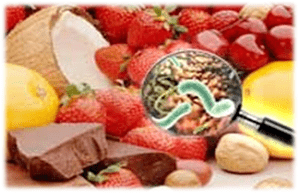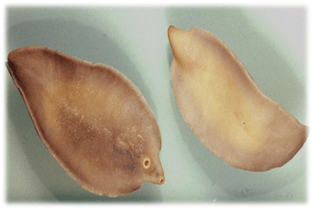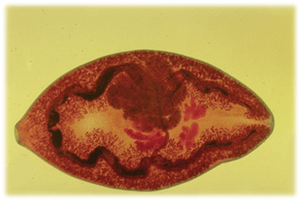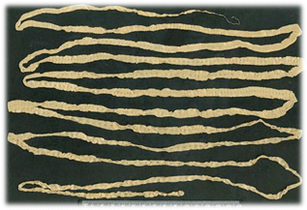There are a large number of different parasites that may exist in a person's internal organs or dwell on his skin and hair.The inclusion of such parasites can be helminths.
Helminths- the general name of parasitic worms living in the human body, other animals or plants.
According to the World Health Organization statistics, more than 4.5 billion people in the world are infected with different parasites, many of which are helminth.
Official reporting statistics of the Russian Federation notice an increase in the incidence of the basic Helminthias in several territories of the constituent entities of the Russian Federation, in particular: Echinococcosis, opisthorchiasis.In a number of territories, indicators of enterobiosis incidence and ascaridosis remain at a high level. There are many ways to get into the human body, however, one of the most common ways of infection is infection through food products.Poorly washed vegetables, fruits or herbs, fried or boiled meat or boiled, fish, poultry, improperly treated foods can lead to infection with helminths.
There are many ways to get into the human body, however, one of the most common ways of infection is infection through food products.Poorly washed vegetables, fruits or herbs, fried or boiled meat or boiled, fish, poultry, improperly treated foods can lead to infection with helminths.
You can become infected in the event of improper preservation of the finished product, for example, sweet paste storage without protective packaging can lead to infection with helminths whose eggs can enter the finished product using flies or other insects.
Let's try to figure out which helminths are transmitted with food and are the most common in our country, and how to minimize the risk of infection with them.
Supreme (cat, hepatic, lanceolate, etc.)
Fascicose
In humans, more than 40 types of subsidies can parasitize, while the localization of helminths in the body can be very different - the liver, light, blood vessels.
The hepatic borrower is the causative agent of fascioliasis and affects the liver and gall bladder.
A person is infected when using vegetable garden crops for water irrigation from open ponds.
Patients have general symptoms of intoxication - weakness, decreased appetite, nausea, headaches.Allergic reactions can occur in the form of itching of the skin or urticaria, asthmatic attacks.
An increase in the size of the parasite can lead to a violation of the bile flow in the duodenum and the appearance of mechanical jaundice signs.Patients have pain in the proper hypochondrium.Next, the yellownness of the skin can be observed and the feces whiten.
Opistorchoz
The causative agents of opistrchiasis are a cat plate.
Human infection occurs when raw fish, not thermically processed or salty.
The clinical manifestations of opisthorchiasis are characterized by a considerable variety.It depends on the individual characteristics of the body as well as the intensity and duration of the infection.The number of parasitic worms can fluctuate in a large range: from the only parasites to a few tens, and even hundreds.Repeated use of infected fish leads to an increase in infection and worsening clinical manifestations.Clinically, the disease can be associated with an increase in temperature in patients, the appearance of urticaria, itching of the skin, muscles and joint pain.Patients may have pain in the right hypochondrium, a severe feeling in the stomach, nausea.

Paraonism
The leading cause of paramodic in humans is a pulmonary bacon.
The causative agent of the disease enters a person's intestines when eating crustaceans living in areas, where there is a focus of the disease, and migrates through the body: they penetrate the intestinal wall into the abdominal cavity, and then enter the pleural cavity through the diaphragm, then into the lung tissue.Longer larvae can also penetrate organs and other tissues.Localization of the parasite in the brain is particularly dangerous.Parasite pulmonary localization occurs in a third of infected people and is often the cause of death.
In the early stage of the disease, when pulmonary bacon migrates only throughout the body, the disease continues almost asymptomatic.Sometimes minor allergic reactions, itching of the skin are possible, less often - abdominal pain, jaundice.Once the parasite reaches the final localization, patients have highlighted symptoms of lung damage: persistent cough with abundant saliva, severe chest pain.During the disease, various complications can occur, for example, pneumothorax - the air that enters the pleural cavity.Very often in patients, pneumonia or pleurisy develop (inflammation in the pleural cavity).
Ribbon worms
Cestodes worms - a group of parasitic worms that have a strip shape and consisting of a different number of anatomically insulated segments - swallowing.The dimensions of the worms vary from a few millimeters to 10-15 meters or more.At the front of the worm, the head is located, which is a parasite fixing organ in the human intestinal mucosa.Helmine is fixed to the intestinal wall using various accessories - rounded suction cups or cracks, hooks.
Difillobotriosis
The causative agent of dipillobotriosis is a wide tape, which lives in a person's intestines.
The tape is wide at a length of 12-15 meters or more, and the number of segments-thousands separate.

Human infection occurs when it is not processed enough, thermically processed, fresh frozen, poorly chopped, weak and unsaturated, crushed fish, and when using fresh salty fish.Clinical photography is due to the mechanical effect of helminth on the intestinal mucosa and the absorption of nutrients.Patients with dipillobotrosis complain of pain and laziness in the stomach, nausea, vomiting.There is often an excrement disorder.With the simultaneous parasitization of some worms, intestinal obstruction can occur.
The tape adorns vitamin B12 on its surface, and this leads to a violation of red blood cell formation in the patients' body and the appearance of anemia.Patients have skin pallor, weakness, mistreatment.
Tonary
The causative agent of the shade is a bull upholstery, which is located by a person's small intestine and can reach a length of 10 meters.
People are infected with tusarinchosis when they eat meat infected with livestock (poorly fried or cooked, wire, minced meat).
Tusirinchosis often persists asymptomatic and is accidentally detected when the patient sees in his feces a parasite segment, either detects them in bed or in clothes.During interrogation, the patient may complain that he recently feels weakness, increased fatigue, sleep disturbance, skin of thunder in the abdomen, pain in the right region honored, vomiting, chair disorders.
As a complication of tusirinchosis in patients, an attack of acute appendix or intestinal obstruction may occur.
Deng
The causative agent of tinosis is a pork chain that is localized in a person's small intestine and can reach a length of 3 meters.
Pork meeting can be located in different organs and tissues.
Relatively favorable cystyckosis with localization in subcutaneous tissue or skeletal muscles.

With cystisosis of the eyes, patients complain of distortion of objects, curvature and a gradual decrease in visual acuity.
Cyststicosis of the brain is difficult and often ends with a fatal outcome for a sick person.
echo
The causative agent of echinococcosis is an echinococcus, which is localized in the liver and lung and can reach a length of 5-6 meters.
For a person, infection with echinococcus is possible with the use of garden crops, vegetables or fruits, which may be parasite eggs.
The clinical manifestations of the disease depend on the size, quantity and localization of echinococcus bubbles in the patient's body.With the localization of echinococcus in the liver, patients complain about the severity and pain in the proper hypochondrium, as well as the skin yellowness as a result of a bile flow violation.Large cysts, by squeezing the gate vein, lead to a violation of venous blood flow from the intestines and the appearance of ascites - the accumulation of the fluid in the abdominal cavity.
When located in the lungs, dry cough and breathing pain are related to breathing.
Alveococcosis
The causative agent of alveococcus is alveococcus, which affects the liver with possible subsequent metastases in various other organs.The size of the alveococcus does not exceed 5 mm.
A person is infected when eating unwashed wild herbs and forest berries, as well as when eating products, washing which is performed in an open basin.
In the early stage of the disease, patients are concerned about weakness, mistreatment, headaches, itching of the skin.In the future, complaints may appear for a severe feeling in the right hypochondrium;Vomiting, diarrhea, bloating, especially after eating fatty foods.
The patient's condition worsens significantly when alveococcus enters other organs.The most dangerous metastases to the brain, kidneys, lungs.Despite the backdrop of the patient's immune system braking, bubbles are suppurities very often, abscesses occur in the internal organs, which even aggravate the patient's condition and may be the cause of death.
Round worms (nematodes)
Round worms are one of the most types of worms.Diseases caused by round worms are called nematodosis.
The nematode body has a form formed or threaded with fingers, connections to the edges, rounded to the cross section, the size of the worm round may be different, but most often does not exceed 0.5 meters.
Acaridosis
The causative agent of ascaria is ascaris, a parasitizer in a person's small intestine.The size of mature worms can reach 40 cm.
The main and only possible mechanism of human infection with ascaridosis is fecal-oral.Unwashed vegetables or fruits, water, household items, dirty hands are the main transmission factors.And if you remember the mechanical egg carriers - insects, then the list of products in which the eggs of the ascarid can be extremely large.
The clinical manifestations of askariasis depend on the amount of parasites in the small intestine.Most often, an individual lives in a person's intestines - then the disease is most often asymptomatic.
In the presence of some individuals in the body, patients have signs of body intoxication with worm products.Patients complain of dizziness, headaches, sleep disturbance.There is a severe feeling in the stomach, unstable chair.When parasitizing a large amount of ascarids, symptoms of intestinal obstruction may occur.
Enterobiosis
The causative agent of enterobiosis is cuts, which are localized in the intestines, and can reach a size of up to 1 cm.
The only way of infection with cuts is fecal-oral.Unwashed vegetables and fruits, household items, dirty hands are the main factors of transmission.Insects can also be cubs of cutting eggs for food.
When parasitizing a small number of parasites, an asymptomatic course of the disease is possible, while in the presence of a large number of parasites, itching is observed in the anus, patients are possible in abdominal pain, nausea and excrement disorder.
During migration of women, women can penetrate the genitals with the subsequent appearance of the inflammatory process in them.
Tricinosis
The causative agent of trichinellosis is trichinella, which is localized in the small intestines and skeletal muscles of the host.

Trichinella is one of the smallest nematodes.The sizes of the parasites barely reach 4 mm.Adult trichinellas parasitize in the small intestine, and in the larval stage in the muscles with transverse strips, the exception is the heart muscle.
A person is infected, using infected animals - wild pigs, pigs, bears, seals.For infection, it is enough to use 30-50 g of trichinelle meat.Most often, a person is infected with the use of meat, fat, bacon, bacon, bracelets, as well as sausages made from infected animals.
Trichinellosis is clinically manifested by general symptoms of the disease, headache, fever at 38-39 ° C.
Shortly thereafter, a pronounced eyelid edema appears or the whole face, sometimes swelling of the limbs.These symptoms add muscle pain - calf, chewing, lumbar.Gradually, muscle pain intensifies, spreads to new muscle groups.The patient's movements become increasingly limited, sometimes to complete immobilization.
The patient's body intoxication with parasite life products leads to damage to the heart, lung, brain and may be the cause of the patient's death.
Prevention of Helminthiasis
To prevent infection with helminths, some rules must be followed, namely:
- Observe the simplest rules of personal hygiene, including hand washing, before meals, after contact with money and animals.
- Try to avoid contact with stray animals, and if you have a pet, visit a veterinary clinic regularly.It is necessary to develop animal passage courses with the frequency recommended by the veterinarian.
- Wash fruits, vegetables, berries thoroughly, even if they are from your personal plot.
- Do not drink water and do not wash the dishes and food with water, the safety you are not safe for.
- Eat only products that have passed the necessary heat treatment.
- Provide insect protection in your kitchen.For example, to capture the window openings, cover the ready -made dishes.
- Do not eat dried or dried fish at home.
- Do not use home -made salty strips.














